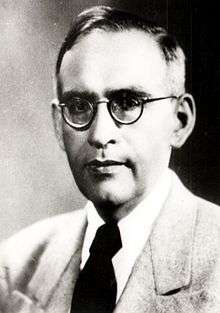Mahmoud Hessabi
| Mahmoud Hessabi | |
|---|---|
 Mahmoud Hessabi | |
| Senator from Tehran | |
|
In office 22 January 1950 – 9 May 1961 | |
| Appointed by | Mohammad Reza Shah |
| Minister of Culture and Higher Education | |
|
In office 6 May 1951 – 16 July 1952 | |
| Prime Minister | Mohammad Mosaddegh |
| Preceded by | Karim Sanjabi |
| Succeeded by | Mehdi Azar |
| Personal details | |
| Born |
23 February 1903 Tehran, Iran |
| Died |
3 September 1992 (aged 89) Geneva, Switzerland |
| Resting place | Tafresh, Iran |
| Nationality | Iranian |
| Alma mater | American University of Beirut, Sorbonne, École Superieure d'Electricité |
| Occupation | scientist |
Sayyed Mahmoud Hessabi (or Hessaby, Persian: سید محمود حسابی, February 23, 1903 – September 3, 1992) was an Iranian nuclear physicist and senator[1] He was the Minister of Education for Iran in the cabinet of Prime Minister Mohammad Mosaddegh from 1951 to 1952.[2]
Life
Hessaby was born in Tehran to the family of Abbas and Goharshad Hessabi. His family's hometown is Tafresh, Central Iran.[3] At the age of four, his family moved to Beirut where the young Hessaby attended primary school. He was still in secondary school when World War I started prompting the closure of his school; Hessaby continued his studies at home and in 1922, he earned a degree in road engineering from the American University of Beirut. After briefly working for the Ministry of Roads, Beirut, Hessabi traveled to Paris for further education, he was awarded a degree in electrical engineering at the École Superieure d'Electricité and later a doctorate degree in 1927. In Paris, he worked Aime Cotton.[4]
In Tehran, Hessabi was affiliated with the University of Tehran and organized the science and engineering faculties of the university, he was a teacher of Alenush Terian while she studied at the university.[5] In June 1951, Hessabi was appointed to a three-man provincial board of the Iranian oil company, the designated successor of the Anglo-Iranian Oil Company. In December, 1951, he replaced Karim Sanjaby as education minister.[1] Between 1961 and 1969, Hessabi was Iran's representative on the Scientific and Technical Subcommittee, United Nations Committee on the Peaceful Uses of Outer Space.
Selected works
- Hessaby M. (1947). "Continuous Particles". Proceedings of the National Academy of Sciences of the United States of America. 33 (6): 189–194. Bibcode:1947PNAS...33..189H. doi:10.1073/pnas.33.6.189. PMC 1079021. PMID 16588741.
- Hessaby M. (May 1948). "Theoretical Evidence for the Existence of a Light-Charged Particle of Mass Greater than That of the Electron". Phys. Rev. 73 (9=): 1128. Bibcode:1948PhRv...73.1128H. doi:10.1103/PhysRev.73.1128.
See also
References
- 1 2 "Iran Bank Fights Drain on Exchange: Opening of Credit Abroad for Imports Suspended in Step to Protect Currency". New York Times. New York. December 5, 1951.
- ↑ Alexander, Yonah; Nanes, Allan S. (1980). The United States and Iran: A Documentary History. Aletheia Books. p. 244. ISBN 9780890933787.
- ↑ "Iranian Personalities: Professor Mahmoud Hessaby". Iran Chamber Society.
- ↑ Tarikhi, Parviz (2014). The Iranian Space Endeavor: Ambitions and Reality. Springer. p. 47.
- ↑ Talebian, Mohammad; Talebian, Ehsan (2012). "Alenush Terian: The Iranian Solar Mother". Physics in Perspective. 14 (2): 239–241. Bibcode:2012PhP....14..239T. doi:10.1007/s00016-012-0085-x.
External links